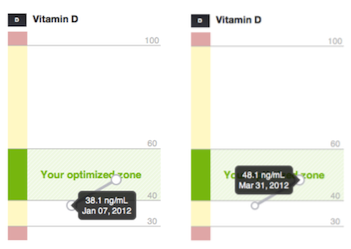What were the results of your first InsideTracker blood analysis? If some of your biomarker results were out of the optimal range, did you change your diet and exercise regimen to improve your health and athletic performance? If you want to know how much progress you have made, sign up for a follow-up InsideTracker blood test!
What are the benefits of a follow-up test?
A follow-up test is the most accurate way to determine how well any diet or fitness changes are helping to improve your biomarkers. Take the example of Marina Zdobnova, an InsideTracker customer since January, 2012. She states: “I was very curious how much my biomarkers had improved since I followed the recommendations from the first test. The first time, six of my biomarkers were outside of my optimal range.”
Because the information that Marina learned from her first blood analysis proved to be so useful, she scheduled a follow-up test four months after her original test. The results? Thanks to a healthier diet and a new exercise routine, she had improved three of those sub-optimal biomarkers. “I was eating specific foods and avoiding other foods to increase results,” she said.
“It is so easy to be lazy and just say that you can make exceptions and not be consistent with your diet,” Marina said, “so it is important to follow recommendations closely and constantly be in the know about what is happening in your body.”
When should you schedule your second test?
The answer depends on your activity level, your performance goals, and which markers you are trying to optimize. If you are just beginning to exercise or are coming back from an injury, get a baseline blood analysis, then retest in three months to assess your progress. If you participate in a seasonal sport such as running, rowing, triathlon, or soccer, test before your season begins to get your baseline biomarker levels and set your goals. Then test again at the end of the season. 
Different biomarkers change at different rates. For example, the results for vitamin D, white blood cells, and c-reactive protein can improve in as little as two months, while it may take three months or more to notice a significant reduction in your cholesterol. In general, if you make and maintain changes in nutrition, supplements, and exercise, retesting every three months is ideal for measuring your progress.
The easiest way to order a follow-up test is to click the “you should consider retesting” link that appears at the top of your Bloodwork page. If you purchased a two-test plan, then the link will take you to the screen for scheduling a test. If you need to purchase a follow-up test, then the link will take you to the screen for choosing a test. It’s a very user-friendly process!
What can you expect from your second test?
The blood analysis process for your follow-up test is the same as the first. After you register for your plan online, you will be directed to one of 1,500 blood testing centers nationwide, where you will have your blood drawn and analyzed. We also have an at-home or at-office option available in some areas for an additional fee.
After your follow-up blood analysis, InsideTracker will provide you with:
Graphs displaying your personalized blood results and optimal numbers. These graphs show all the tests that you have taken so that you can see trends in your bloodwork analysis. Explanations of the role that each biomarker plays in health and athletic performance. Lifestyle, exercise, and nutrition recommendations for improving biomarkers that are out of your optimized zone. InsideTracker updates your recommendations in response to the results of each follow-up test that you take. A unique food plan that is customized to fit your individual needs and preferences. Like your nutrition recommendations, your food plan will be tailored to your new results.What benefits do you get from a follow-up test?
Just like your race time or the amount of weight that you are lifting, your blood test results can provide measurable facts about your body. Most importantly, a follow-up test is a terrific way to see how your results have changed over time. A second test, provides important information about the present status of your biomarkers and any trends. Your follow-up blood analysis report can point out areas that need adjusting or refocusing, and also are a great motivator to help you stay on track!
Rob Montgomery, another InsideTracker customer, was surprised by the results of his first test. “I thought all along I had abnormally high inflammation, but the test indicated that I was in the middle of the acceptable range. Knowing that information helped me focus my efforts in other important areas,” he said. Montgomery added that he was most interested in the biomarkers that are related to heart disease, such as cholesterol, so he was particularly interested to see if they had improved since he received the results of his first test.
So, what did Montgomery gain from his follow-up test? “Having access to these tests helps me gauge my progress in becoming fitter, as well addressing certain trouble spots,” he enthused.
One of Montgomery’s favorite features of the follow-up test was the trend lines on the biomarker graphs, which allowed him to check his progress since his first test. “With this information, I’ve been able to make gradual yet permanent changes, and the trend lines are a great motivator to help keep me on track,” he said.
The most effective way to use InsideTracker is have regular follow-up tests. That way, you can track your progress over time and stay motivated to optimize your results. With a little hard work and some help from InsideTracker, you’ll be on your way to achieving your fitness and performance goals!
